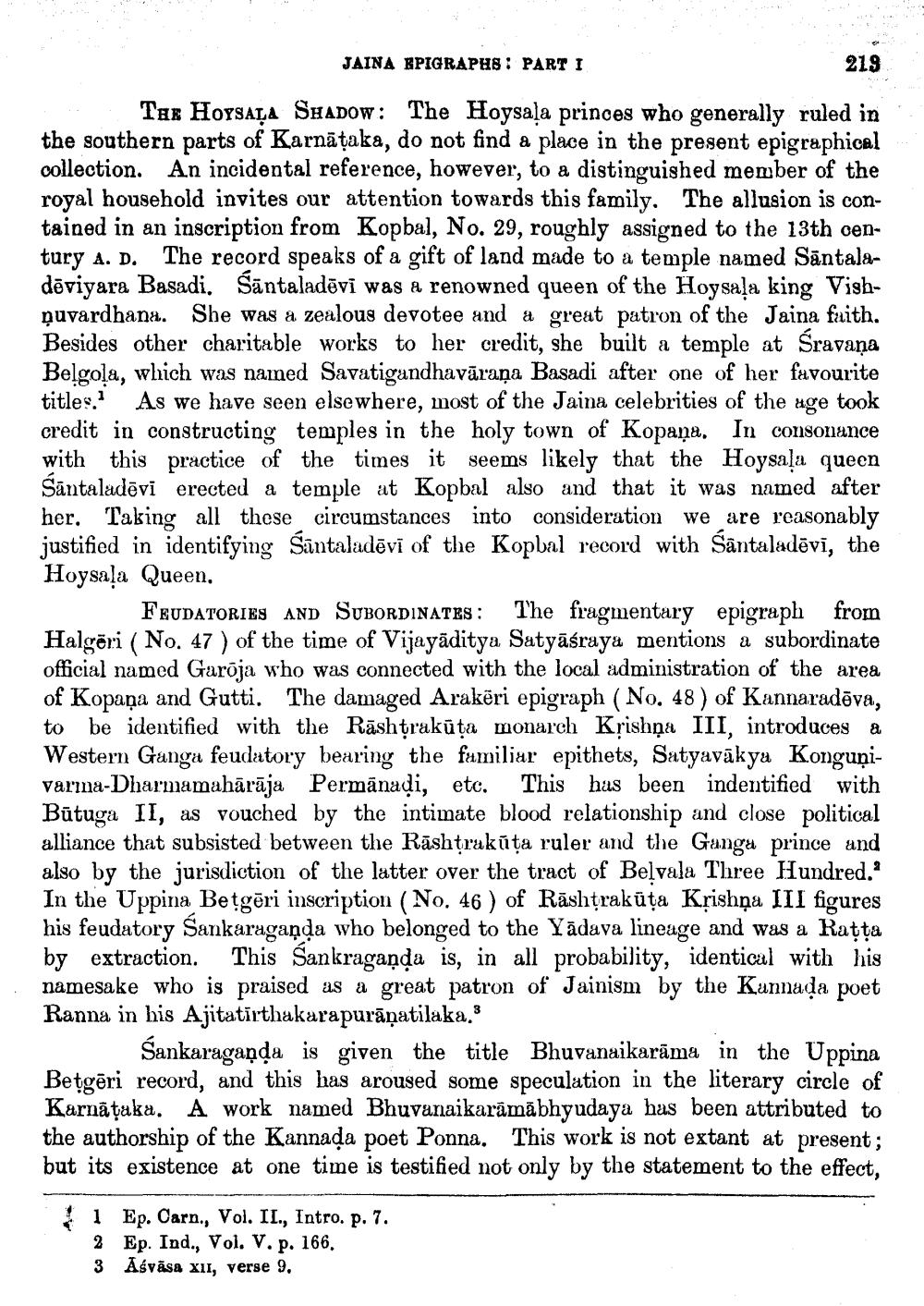________________
JAINA EPIGRAPHS: PART I
213 Tax HOYSAĻA Shadow: The Hoysaļa princes who generally ruled in the southern parts of Karnāțaka, do not find a place in the present epigraphical collection. An incidental reference, however, to a distinguished member of the royal household invites our attention towards this family. The allusion is contained in an inscription from Kopbal, No. 29, roughly assigned to the 13th century A. D. The record speaks of a gift of land made to a temple named Sāntaladēviyara Basadi. Sāntaladēvi was a renowned queen of the Hoysała king Vishnuvardhana. She was a zealous devotee and a great patron of the Jaina fuith. Besides other charitable works to her credit, she built a temple at Sravana Belgola, which was named Savatigandhavāraņa Basadi after one of her favourite titles. As we have seen elsewhere, most of the Jaina celebrities of the age took credit in constructing temples in the holy town of Kopaņa. In consonance with this practice of the times it seems likely that the Hoysaļa queen Sāntaladēvi erected a temple at Kopbal also and that it was named after her. Taking all these circumstances into consideration we are reasonably justified in identifying Sântaladēvi of the Kopbal record with Sântaladēvi, the Hoysaļa Queen.
FEUDATORIES AND SUBORDINATES: The fragmentary epigraph from Halgëri ( No. 47 ) of the time of Vijayāditya Satyāśraya mentions a subordinate official named Garõja who was connected with the local administration of the area of Kopaņa and Gutti. The damaged Arakēri epigraph (No. 48 ) of Kannaradēva, to be identified with the Rāshtrakūta monarch Krishņa III, introduces a Western Ganga feudatory bearing the familiar epithets, Satyavākya Konguņivarma-Dharmamahārāja Permānadi, etc. This has been indentified with Būtuga II, as vouched by the intimate blood relationship and close political alliance that subsisted between the Răshtrakūţa ruler and the Ganga prince and also by the jurisdiction of the latter over the tract of Beļvala Three Hundred. In the Uppina Betgēri inscription (No. 46 ) of Rāshțrakūta Krishna III figures his feudatory Sankaragaņda who belonged to the Yādava lineage and was a Ratta by extraction. This sankragaņờa is, in all probability, identical with his namesake who is praised as a great patron of Jainism by the Kannada poet Ranna in his Ajitatirthakarapurāņatilaka.
Sankaraganda is given the title Bhuvanaikarāma in the Uppina Betgēri record, and this has aroused some speculation in the literary circle of Karnāțaka. A work named Bhuvanaikarāmābhyudaya has been attributed to the authorship of the Kannada poet Ponna. This work is not extant at present ; but its existence at one time is testified not only by the statement to the effect,
1 Ep. Carn., Vol. II., Intro. p. 7. 2 Ep. Ind., Vol. V. p. 166. 3 Aśvāsa xii, verse 9,




